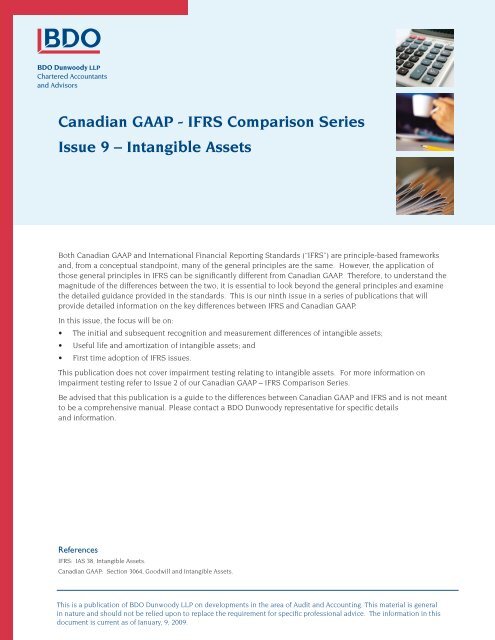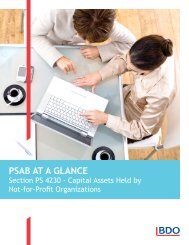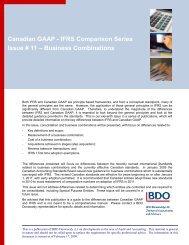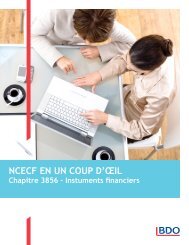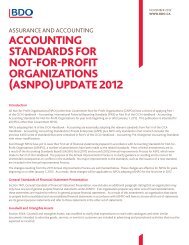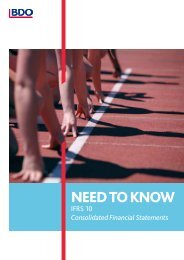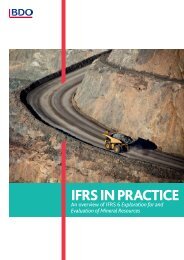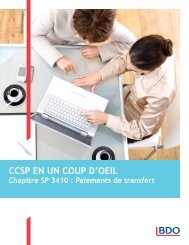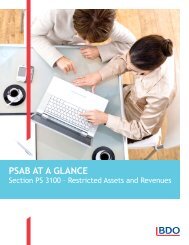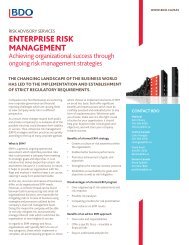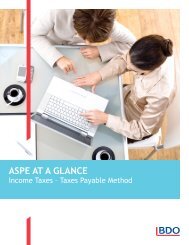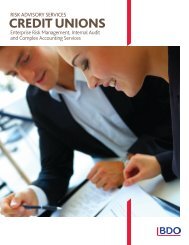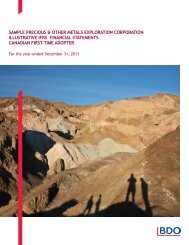Intangible Assets - IFRS Canadian GAAP Differences Series
Intangible Assets - IFRS Canadian GAAP Differences Series
Intangible Assets - IFRS Canadian GAAP Differences Series
Create successful ePaper yourself
Turn your PDF publications into a flip-book with our unique Google optimized e-Paper software.
<strong>Canadian</strong> <strong>GAAP</strong>Limited guidance is provided on the impact of legal,regulatory or contractual provisions on the usefullife. (See above).<strong>IFRS</strong><strong>IFRS</strong> provides more detailed guidance in relationto useful life of an intangible asset arising fromcontractual or other legal rights.The useful life is prohibited from exceeding theperiod of the contractual or other legal rights, butmay be shorter depending on the period over whichthe entity expects to use the asset.<strong>IFRS</strong> also explicitly restricts an intangible asset’suseful life to the shorter of the economic factors andlegal factor periods.Under <strong>Canadian</strong> <strong>GAAP</strong>, Section 3061, Property, Plantand Equipment provides guidance for amortization.Amortization is charged on the greater of i) cost lessresidual value over its estimated useful life, and ii)cost less salvage value (estimated net realizablevalue at the end of its life) over its estimated life.The amortization charge for each period isrecognized in profit or loss.An annual review of the amortization method andestimate of useful life of an intangible asset isrequired.The standard provides specific guidance on howto account for a change in the useful life of anintangible asset from a finite useful life to anindefinite useful life and vice versa.Guidance on amortization is provided in IAS 38.Under <strong>IFRS</strong>, amortization is charged on thedepreciable amount, the cost of an asset, or otheramount substituted for cost, less its residual valueover its estimated useful life.The amortization charge for each period is recognizedin profit or loss unless this or another standardpermits or requires it to be included in the carryingamount of another asset.The amortization period and the amortizationmethod for an intangible asset with a finite useful lifeis reviewed at least at each financial year-end.Guidance is provided on how to account for a changein the useful life of an intangible asset from anindefinite useful life to a finite useful life only.The change in useful life also triggers an impairment test.Recoverability of the Carrying Amount – ImpairmentGenerally, both <strong>Canadian</strong> <strong>GAAP</strong> and <strong>IFRS</strong> require review of the carrying values of intangible assets forimpairment. However, <strong>IFRS</strong> has fundamentally different impairment guidance than <strong>Canadian</strong> <strong>GAAP</strong>impairment guidance. This may have a significant impact for a first time adopting entity, as, in certainsituations, impairment testing is likely to be more frequent under <strong>IFRS</strong> than previously required under<strong>Canadian</strong> <strong>GAAP</strong>. (For more detail, refer to Issue 2 of our <strong>Canadian</strong> <strong>GAAP</strong> – <strong>IFRS</strong> Comparison <strong>Series</strong>publication on Asset Impairments).Retirements and Disposals<strong>IFRS</strong> includes specific derecognition of intangible assets requirements. No guidance is provided inSection 3064.In general, an intangible asset is derecognized on disposal or when no future economic benefits are expectedfrom its use or disposal. The gain or loss, being the difference between the net disposal proceeds, if any, andthe carrying amount of the asset is recognized in profit or loss when the asset is derecognized (unless IAS 17,Leases requires otherwise on a sale and leaseback). Gains shall not be classified as revenue.© BDO Dunwoody LLP 2009 Page 9 of 11
First-Time Adoption IssuesOn first-time adoption of <strong>IFRS</strong>s, an entity’s opening <strong>IFRS</strong> balance sheet should exclude all intangible assetsthat do not meet the recognition criteria included in IAS 38 at the date of transition (e.g. it is probable thatthe future economic benefits that are attributable to the asset will flow to the entity, and the cost of the assetcan be measured reliably).The opening balance sheet should include all intangible assets that meet the recognition criteria in IAS 38 atthe transition date, except for intangible assets acquired in a business combination that were not recognizedin the acquirer’s consolidated balance sheet under previous <strong>GAAP</strong> and also would not qualify for recognitionunder IAS 38 in the separate balance sheet of the acquiree (this is a specific requirement of <strong>IFRS</strong> 1 in relationto business combinations – refer to paragraph C4(f) of Appendix C of <strong>IFRS</strong> – 1 (Revised)).If an internally generated intangible asset qualifies for recognition at the date of transition to <strong>IFRS</strong>s, anentity recognizes the asset in its opening <strong>IFRS</strong> balance sheet. However, an entity is not permitted to useevidence post the date of transition to retrospectively reconstruct the costs of the intangible asset.Therefore, first-time adopters that did not recognize an intangible asset under <strong>Canadian</strong> <strong>GAAP</strong> are permittedto capitalize internally generated intangible asset costs only where they had anticipated the IAS 38 and <strong>IFRS</strong>1 documentation requirements and established their intangible asset at the same time as under <strong>Canadian</strong><strong>GAAP</strong>. If the asset does not qualify for recognition under IAS 38 until a later date, its cost is the sum of theexpenditure incurred from that later date. This will be less of an issue for <strong>Canadian</strong> entities that are nowcomplying with Section 3064.For an intangible asset acquired in a business combination before the date of transition to <strong>IFRS</strong>s, itscarrying amount under <strong>Canadian</strong> <strong>GAAP</strong> immediately after the business combination is its deemed costunder <strong>IFRS</strong>s at that date. If that carrying amount was zero, the acquirer does not recognize the intangibleasset in its consolidated opening <strong>IFRS</strong> balance sheet, unless it would qualify under IAS 38 for recognition atthe date of transition to <strong>IFRS</strong>s in the balance sheet of the acquiree. If so, the acquirer measures the asseton the basis that IAS 38 would require in the balance sheet of the acquiree with the resulting adjustmentaffecting goodwill.Deemed CostAn entity may make an election to use one of the following as deemed cost of an intangible asset at the dateof transition to <strong>IFRS</strong>:i) Fair value at the date of transition; orii) A revaluation under previous <strong>GAAP</strong> that is broadly comparable to fair value; or cost or depreciated costunder <strong>IFRS</strong>s, adjusted to reflect (e.g. changes in a general or specific price index).However, this exemption is only available to an entity for intangible assets if, and only if, it meets therecognition criteria (e.g. reliable measurement of original cost) and the revaluation criteria included in IAS38 and discussed above. The revaluation criteria require the existence of an active market. Existence of anactive market for intangible assets is uncommon. It would also be uncommon for an entity that hascomplied with <strong>Canadian</strong> <strong>GAAP</strong> to have made a revaluation in accordance with previous <strong>GAAP</strong> that meetsthe criteria above.If the entity’s amortization methods and rates under <strong>Canadian</strong> <strong>GAAP</strong> are acceptable under <strong>IFRS</strong>s, theentity does not restate the accumulated amortization in its opening <strong>IFRS</strong> balance sheet. Instead, the entityaccounts for any change in estimated useful life or amortization pattern prospectively from the period whenit makes that change in estimate. However, in some cases, an entity’s amortization methods and rates under<strong>Canadian</strong> <strong>GAAP</strong> may differ from those that would be acceptable under <strong>IFRS</strong>s. If those differences have amaterial effect on the financial statements, the entity adjusts the accumulated amortization in its opening<strong>IFRS</strong> balance sheet retrospectively so that it complies with <strong>IFRS</strong>s.© BDO Dunwoody LLP 2009 Page 10 of 11
ConclusionIn general, the principles relating to accounting for intangible assets under <strong>Canadian</strong> <strong>GAAP</strong> and <strong>IFRS</strong> areconverged. However, when looking at the details of each standard there are also some differences of whichan entity needs to be aware and needs to determine whether those differences will have an impact on theway intangible assets are accounted for upon moving to <strong>IFRS</strong>.If you require further guidance on asset impairment testing under <strong>IFRS</strong> or any other <strong>IFRS</strong> information orreference sources, please contact your local BDO Dunwoody LLP office or visit www.bdo.ca/ifrs.BDO Dunwoody LLP is a Member Firm of BDO International. BDO International is a world wide network of publicaccounting firms, called BDO Member Firms, serving international clients. Each BDO Member Firm is an independentlegal entity in its own country.Page 11 of 11


